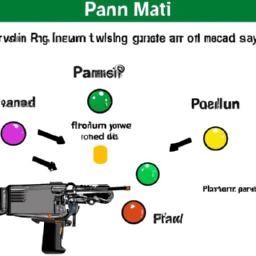How Does A Paintball Gun Work Explained
How Does A Paintball Gun Work
How Does A Paintball Gun Work?
Paintball guns, otherwise known as markers, have become one of the most popular and beloved outdoor team activities on the market. Whether you're a beginner or a professional, there's no denying the sheer thrill of testing your skills against friends and family. But before every round can begin, there's the need to understand how does a paintball gun work?
In this article, we look at 8 primary threads to understand the mechanics behind paintball guns. These include the internals of the gun, the different types of markers, the working principle of the weapon, triggers and pistol grips, gas systems and tanks, barrel designs, and maintenance and cleaning methods. We'll conclude the article with a section titled In Summary for a clearer understanding of the process.
The Internals of a Paintball Gun
A paintball gun, like any other gun, is composed of a variety of internal parts. These parts include the trigger, the barrel, the bolt, and the valves. The trigger is the most important part, as it allows the user to fire a shot when pulled. The barrel is where the paintball is housed before it is fired. The bolt is the mechanism that pushes the paintball out of the barrel when the trigger is pulled. The valve is the mechanism that is used to control the pressure of the gas used in the gun.
Different Types of Paintball Markers
There are a few types of paintball markers, depending on the model. The most popular type is the pump-action gun, which uses a bolt system to move the paintball from the barrel to the target. The other type is semi-automatic guns, which are powered by CO2, air, nitrogen, or compressed air. Semi-automatic guns are more popular with veteran players, as they offer a higher rate of fire.
The Working Principle of a Paintball Gun
Paintball guns rely on pneumatics and compressed gas to fire. The gun uses a pressure chamber to store the compressed gas, and the trigger releases this gas into the barrel, propelling the paintball forward towards the target. As the paintball leaves the barrel, the pressure chamber is re-filled by the compressed gas, allowing the gun to fire again when the trigger is pulled.
Triggers and Pistol Grips
Triggers and pistol grips can vary from model to model. In most cases, they are either mechanical or electronic. Mechanical triggers require the user to manually activate the trigger, while electronic ones are activated with the press of a button. The type of trigger used will depend on the type of paintball gun as well as the user's preferences.
Gas Systems and Tanks
Paintball guns rely on compressed gas in order to fire and this gas comes from tanks that are attached to the gun. The type of gas used in the gun varies depending on the model and the type of paintball used. CO2, air, nitrogen, and other compressed gases can all be used in the tanks.
Barrel Design
Paintball guns come in a variety of barrel designs, from smoothbore to rifled. Each design has its own unique advantages and disadvantages and the type chosen is dependent on the user's preferences. Smooth-bore barrels are generally easier to maintain and offer greater accuracy, while rifled barrels offer greater accuracy and control over the shot placement.
Maintenance and Cleaning Method
Paintball guns require regular maintenance and cleaning in order to keep them in good working order. This includes lubricating the internal parts of the gun, as well as cleaning and replacing parts if necessary. Proper maintenance and cleaning is essential for optimal performance, and can help to extend the life of the gun.
In Summary
Paintball guns are fun team activities for any age and skill level. Knowing how these guns work and the different components inside them is beneficial for all shooters. We've looked at 8 primary threads to help you understand how a paintball gun works. This includes understanding the internals of the gun, the different types of markers, the working principle of the weapon, triggers and pistol grips, gas systems and tanks, barrel designs, and maintenance and cleaning methods. With this knowledge, you can now go ahead and enjoy the thrill of paintball with your friends.

Previous Page
Next Page
